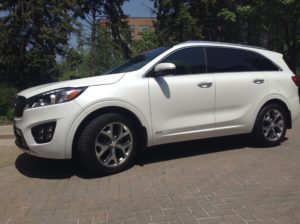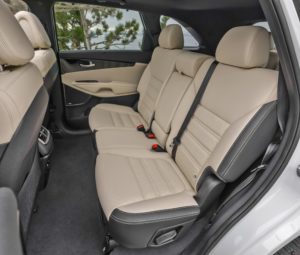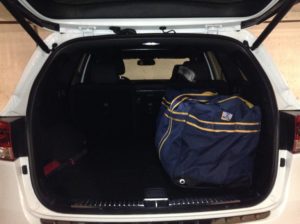So-called budget brands continue to ascend into territory previously dominated by higher-end marques, so I wasn’t entirely surprised by how pleasing a week I spent with the Kia Sorento 2.0L SX AWD.

First impressions
The third-generation Sorento is a sleek, solid-looking SUV. My white tester sported the SX appearance package, 19-inch polished alloy wheels and Kia’s more pronounced front grille. The twin four-foglight openings in front also stood out, while the spoiler at the top of the rear liftgate completed the look.
Interior
The mirrors, folded in when the driver approaches, move into position when the driver unlocks the door. (They also fold back in when the driver locks the Sorento.) This was my first clue that Kia designed a higher-end feel in electronics as well as exterior looks.
There’s a subtly luxurious feeling throughout the cabin. Certain piano black touches on the dash and the upper quarter of the steering wheel mesh well with leather seats. All the seats are heated, while the front two are also cooled. T he driver’s seat features a thigh extension and three presets. Four-way headrests help occupants get just the right feel in the vehicle.

image courtesy Kia
Press a ceiling-mounted button, look up, and you’ll see a panoramic sunroof that stretches just about the whole length of the Sorento, minus the part of the roof near the liftgate where the fin antenna sits.
A hands-free Smart Power Liftgate opens when it senses the key fob nearby for two seconds.
The cabin is long enough to accommodate a third row, a feature my tester did not have. Given how much wider this model Kia made this model compared to its predecessor, buyers who choose the third row option can comfortably accommodate 7 passengers.

image courtesy Kia
Hockey bag test
As expected, no problems here. The liftgate beeped and raised itself, and I slid the bag in lengthwise with room to spare.

I figured out that I could fold down the middle 20 per cent of the rear seat to slide my sticks along the floor of the cargo area. There’s easily room for two bags to fit lengthwise, and room enough for two more bags on top of that, before thinking about folding one of the second-row seats.
Here’s a clearer view of the cargo area, one with optional third-row seating.

image courtesy Kia
Kia supplies a power outlet in the Sorento’s cargo area as well.
In-cabin technology
An eight-inch multimedia screen lets occupants run through the gamut of its infotainment (radio, CD, satellite radio, smartphone connection, Android Auto) and navigation options.
The screen proved perfectly usable, as did the physical controls. Kia provides a column of buttons to either side of the screen that jump to commonly accessed features. Just under the buttons are knobs for power/volume and tuning. The whole setup was easy to get used to as was the sound coming out of the Infinity sound system.
The centre “circle” of the instrument cluster is a display, not an analog gauge. None of the screens in this display are too busy for a quick glance down. A steering-wheel-mounted control lets the driver thumb through various bits of information like fuel economy, distance and other information about the Sorento’s performance.
Driving
Kia lets buyers choose one of three engines for their Sorentos. There’s a 2.4-litre 4-cylinder GDI for fuel economy (185 hp) and a 3.3-litre V6 GDI for power (290 hp, towing up to 5,000 lbs).
My tester sported the “in-between” engine, a new 2.0-litre 4-cylinder GDI turbo that can deliver 240 hp. From the moment I drove away from Kia’s Toronto-area offices in the Sorento, it surprised me with a responsiveness I found un-SUV-like, and pleasing. Contributing to the nimble road feel was a structure that uses more than twice the amount of ultra high strength steel found in the previous generation. It enhances torsional rigidity by 14 percent over said previous generation.
A six-speed automatic ships standard on the Sorento, transmitting power to the Dynamax™ all-wheel drive system.
Kia hasn’t spared any modern under-the-hood (or behind-the-bumpers) technologies. A blind spot detection system beeped at me plenty. It was set to a wider scope of detection than I’m used to. I’m not complaining – it’s better than blind spot myopia.
Active safety features like Electronic Stability Control and a Traction Control System kept the Sorento in check even when I let it run a little loose. A Brake Assist System,Hill-start Assist Control, Electronic Brake Force Distribution and Antilock Braking System round out the standard set of active safety technologies. All-wheel-drive models also get Roll Over Prevention and Advanced Traction Cornering Control. Other available technologies include Vehicle Stability Management, Smart Cruise Control, Rear Cross Traffic Alert and 360o Camera Monitoring.
Fuel economy
The vehicle sticker claims 10.9L/100km overall, getting 12.3L/100km in the city and 9.3L/100km on the highway. Much of my driving was in the city, and the number given seems about right. Fortunately, the Sorento takes regular 87 fuel.
You can dial performance down to Eco or bump it up to Sport using the Sorento’s drive mode selector. Expect fuel economy to either improve or diminish, respectively.
Pricing
The base Sorento starts at $27,695. My tester retails for $44,110 after taxes and fees.